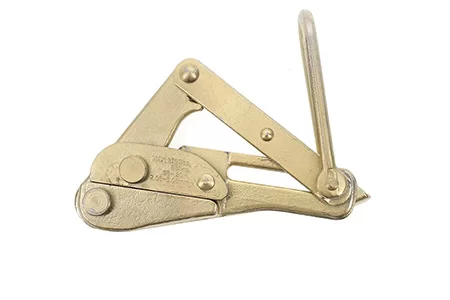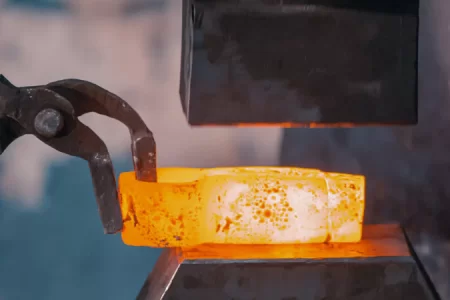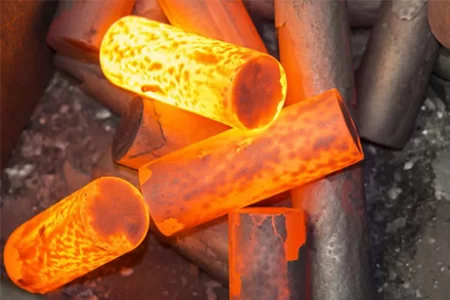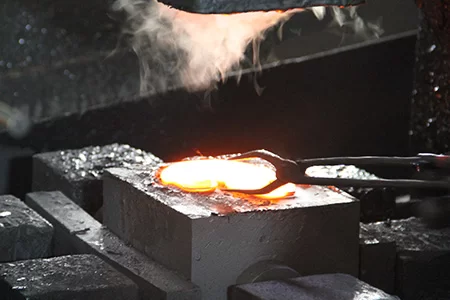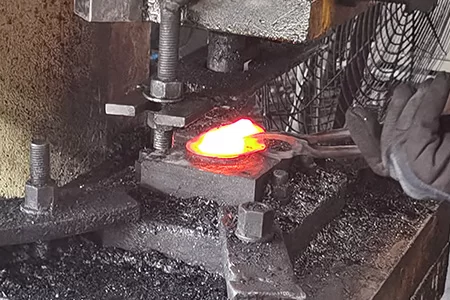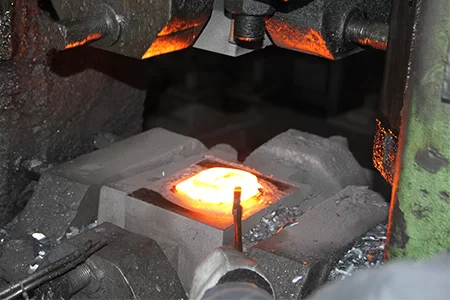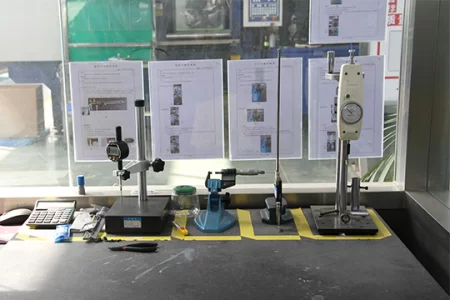By sharing knowledge, experience and views in the field of forging technology, we help you understand, learn and apply relevant technologies.

Hulk Metal Forging Technology
Share technical experience
-
Home>
-
Blog>
-
Technology>
The Blanking Method of Hot Forging
Hot forging is a critical process in metalworking, used to create components of high strength and durability. During the forging process, a metal workpiece is heated to a malleable state and then shaped using mechanical force. One of the essential steps in this process is blanking — the act of preparing the metal by cutting it into appropriate shapes or sizes before it undergoes the actual forging operation.
The blanking method directly impacts the efficiency, material utilization, and overall quality of the final forged product. Selecting the right blanking technique is crucial, as it affects the material properties, tooling wear, and production speed. In this article, we will explore the various blanking methods used in hot forging, their advantages, disadvantages, and how to choose the best method for different materials and forging requirements.
Understanding the Blanking Process in Hot Forging
Blanking, in the context of hot forging, refers to the process of cutting metal into a blank or preform that is then further processed into a finished product. Before a metal bar or billet is heated and deformed, it needs to be prepared into manageable shapes that fit the required forging parameters. Blanking can be performed in a variety of ways depending on the material properties, the size of the billet, and the specific requirements of the forging process.
The primary objective of blanking is to provide a standardized, consistent starting point for the forging operation. A high-quality blank ensures that the forging process can proceed smoothly, with minimal material waste, and with optimal results. Each method of blanking has its own specific use case, with varying results in terms of surface finish, dimensional accuracy, and material loss.
Types of Blanking Methods in Hot Forging
The following are the most commonly used blanking methods in hot forging:
Sawing
Sawing is one of the most straightforward methods of blanking, where the metal bar is cut into sections using various saws. The three most common types of saws used are circular saws, hacksaws, and high-speed band saws.
Circular Saws:
These saws are powered by a motor that drives a toothed saw blade, which rotates slowly to cut the metal. Circular saws are capable of handling bars up to a diameter of 750 mm, with blades that can reach up to 2 meters in diameter.
Advantages: Circular saws provide a clean, flat cut with high dimensional accuracy, which is essential for ensuring the proper fit in subsequent forging processes.
Disadvantages: The productivity of circular saws is relatively low, and they suffer from significant wear and tear on the blades, leading to higher operational costs and material loss.
Hacksaws:
These saws use a back-and-forth motion to cut through the metal. While hacksaws are effective for smaller bars (less than 100 mm in diameter), they are slower and less efficient for larger volumes.
Advantages: High accuracy and excellent surface finish.
Disadvantages: Low cutting speed and potential for increased tool wear.
High-Speed Band Saws:
These saws are equipped with a continuously moving band of teeth, making them more efficient than hacksaws or circular saws.
Advantages: High production rates and consistent blank quality.
Disadvantages: Expensive initial investment and blade replacement costs.
Shearing
Shearing involves the use of a shearing machine to cut billets into the required size. This method is most suitable for bars with a diameter of less than 200 mm and is often employed in mass production environments.
Cold Shearing:
Cold shearing is applied to billets at room temperature. However, this method generates high levels of stress at the sheared area, which can cause cracks. To avoid this, billets made of high-carbon or alloy steels need to be preheated to temperatures between 350°C and 700°C before shearing.
Advantages: Shearing machines can be automated for high efficiency, reducing labor costs and increasing material utilization.
Disadvantages: The sheared ends may be uneven, particularly when working with larger billets. Additionally, when billets are cut in their hot state, the material may warp, leading to defects in the final product.
Hot Shearing:
Shearing can also be done at elevated temperatures, which minimizes stress but requires specialized equipment to handle the high temperatures of the metal.
Break Off
Breaking off involves the use of a hydraulic press or crank press to apply pressure to a material that has already been pre-cut by methods like sawing or gas cutting. The material is then broken along the pre-cut lines.
Advantages: This method is ideal for harder materials such as high-carbon steels or high-alloy steels (e.g., GCr15, GCr15SiMn, GSiMnMo).
Disadvantages: Pre-cutting is necessary to ensure stress concentrations at the break-off point, which can make the process slower and less efficient. The break-off process can also result in an uneven surface finish.
Grinding Wheel Cutting
In grinding wheel cutting, a rotating grinding wheel (typically less than 3 mm thick) is used to cut through billets. This method is effective for cutting small to medium-sized blanks.
Advantages: This method offers high cutting speeds, smooth cut surfaces, and good precision.
Disadvantages: The grinding wheel wears out quickly, leading to high tool replacement costs. Furthermore, operators must work in less-than-ideal conditions due to dust and heat, necessitating good ventilation.
Flame Cutting
Flame cutting uses a gas cutter or welding torch to heat steel to its melting point, causing it to melt and be cut by an oxygen stream. This method is often used for large billets and forgings that require cutting over thick sections (up to 1500 mm).
Advantages: It can be used for cutting very thick materials and is suitable for rough cutting in large-volume operations.
Disadvantages: Flame cutting can create uneven cuts, and the heat-affected zone may alter the material properties around the cut area.
Anode Cutting
Anode cutting relies on the electrochemical effect of electric corrosion to cut through the material. This method is generally used for materials with a diameter ranging from 30 to 300 mm.
Advantages: It provides high productivity with minimal material waste, as the cutting process is highly controlled and precise.
Disadvantages: Anode cutting is only suitable for specific materials and sizes, limiting its application in some forging processes.
Choosing the Right Blanking Method for Different Materials
The choice of blanking method depends largely on the material being forged and the required properties of the final product. Here are some key considerations:
Material Type:
For high-carbon steels or alloy steels, methods such as break-off or flame cutting may be more suitable, as they can handle the hardness of the material. For softer materials, sawing or shearing might be the more efficient choice.
Billet Size:
Larger billets require methods like flame cutting or circular sawing, while smaller billets are better suited for shearing or grinding wheel cutting.
Production Volume:
Mass production runs benefit from more automated methods like shearing and high-speed band saws, which maximize throughput and minimize labor costs.
Advantages and Disadvantages of Each Blanking Method
Each blanking method comes with its own set of advantages and limitations:
Sawing:
Advantages: Accuracy and good surface finish.
Disadvantages: Low speed and high tool wear.
Shearing:
Advantages: High efficiency, material savings.
Disadvantages: Uneven cuts, stress concentration in the sheared area.
Break-Off:
Advantages: Suitable for high-hardness materials.
Disadvantages: Pre-cutting is required, uneven surface finish.
Grinding Wheel Cutting:
Advantages: High-speed cutting, smooth cuts.
Disadvantages: High tool wear, poor working conditions.
Flame Cutting:
Advantages: Suitable for large billets and thick materials.
Disadvantages: Heat-affected zones, irregular cuts.
Anode Cutting:
Advantages: High productivity, minimal waste.
Disadvantages: Limited material sizes and hardness.
How Blanking Affects the Forging Process
The blanking process plays a pivotal role in the overall success of hot forging. A high-quality blank ensures that the forging process proceeds smoothly without defects such as warping, cracks, or dimensional inaccuracies. Additionally, the choice of blanking method impacts subsequent operations, such as heating, deformation, and surface quality. Poor blanking can lead to issues like inconsistent material flow during forging or inadequate bonding of materials during heat treatment.
Technological Advances in Blanking Equipment
Recent developments in blanking technology have focused on improving the speed, efficiency, and precision of the process. Modern equipment, including high-speed saws, automated shearing machines, and precision grinding machines, offer significant improvements over older methods. Automation in shearing and grinding, for example, reduces labor costs, improves safety, and increases material yield.
Furthermore, advancements in flame cutting technology now allow for better control of the heat-affected zone, reducing the risks associated with irregular cuts and improving the overall quality of the final product.
Blanking is a crucial preparatory step in the hot forging process. The method chosen for blanking directly influences the quality of the final forged product, its material properties, and the overall efficiency of the manufacturing process. By understanding the different blanking techniques—sawing, shearing, break-off, grinding wheel cutting, flame cutting, and anode cutting—manufacturers can optimize their processes for specific materials and production volumes.
Achieving high-quality hot forgings begins with selecting the right blanking method, tailored to the specific material and part requirements. By making informed decisions about the blanking process, manufacturers can improve their forging operations, reduce waste, and ensure the production of durable, high-performance components. As technology continues to advance, the future of blanking and forging looks poised for even greater improvements in efficiency, quality, and sustainability.
Article Navigation
Article Navigation
Industries
Foundries
-

December.11, 2024
Analysis of the characteristics and main uses of wire grip for conductor
READ MORE
-

July.01, 2024
Difference between hot forging and cold forging
READ MORE
-

June.27, 2024
What are the advantages and disadvantages of the hot forging process?
READ MORE
-

February.28, 2025
Open Die Forging: Exploring the forging process and the key factors in selecting a OEM
READ MORE
-

February.24, 2025
Key Considerations for Closed Die Forging
READ MORE
-

February.18, 2025
Factors to consider when purchasing custom forgings
READ MORE
-

February.14, 2025
HULK Metal's hot forging quality control
READ MORE




